 |
|
 |
| |
Ads by Google, based on your browsing history
|
|
2020
December
31
|
What was 2020?
What was 2020? The strangest year most of us have experienced, that's what.
Obviously it's the end of an era and the beginning of a new one.
Just like the 1920s, the 2020s may mark the beginning of the new century
more definitively than the turn of the century did.
We've had two things: a pandemic, which is not over, and a bizarre political
episode, which is ending. So far 1/1000th of the population has died, and ordinary people are
just starting to admit that COVID does kill.
And at this moment our sitting president does not admit he lost the
election, even though the people, the electors, and dozens of courts
have ruled against him.
I know a lot of people have suffered real hardship due to the pandemic.
I've done some things to help them out.
Thank God we have been spared; apart from having to stay home a lot, I've
actually had a very successful year.
As a long-time college teacher,
I especially feel for people in the 16-20 age range, the ones who are supposed
to be becoming less dependent on
their parents, and who really need the company of many
people their own age and the opportunity to travel around.
For them, the pandemic is a real frustration, and I am glad schools
and colleges have been kept open to some extent, and people in this age range
are well served by social media.
But some of the bitterest complaints that I have heard came from people
who suffered no real
hardship or deprivation at all, just a change of routine.
I'm not impressed.
People ought to be adaptable.
Don't brag about being so spoiled that even the cancellation of a football game
or the closing of a bar
seems to make life unlivable.
Fortunately, social media make it easy to stay in touch with friends and
acquaintances; but
unfortunately, on social media
I have seen a remarkable amount of foolishness, some of it close
to the level of psychotic delusion.
People who don't want to believe in COVID, or Biden's victory, or anything else
just choose not to believe it, and surround themselves with others who
suffer the same delusion, and then make pests of themselves.
"Ya gotta watch this video. All the other news media are lying."
Some people have an amazing eagerness to believe one inaccurate report in the
face of a hundred accurate ones, just because it's different.
Fortunately, the problem seems to be subsiding.
Psychiatrists tell us that delusions go away, not because of rational evidence,
but because they lose salience; people pay less attention to them and finally let go.
Maybe some new national leadership
with a less manipulative style
can keep people more focused on reality.
Here's hoping for a saner 2021, even though the pandemic isn't over.
Permanent link to this entry


|
2020
December
29
|
Mamiya/Sekor

I'm at the time of my life where 50th anniversaries of important events are coming
fast and furious, and I'd be remiss if I didn't mention Christmas 50 years ago.
We spent Christmas 1970 at the home of my grandparents Covington, and for the
first time, opened presents on Christmas Eve rather than the next morning.
One of mine was very important — my first SLR camera, a Mamiya/Sekor 1000 DTL.
I was in ninth grade and
was already doing serious 35-mm photography with a rangefinder camera,
bulk-loading Tri-X Pan and developing it myself.
I wanted an SLR for many reasons and my mother semi-surprised me with one
(I had inklings but not certainty).
The camera you see above is not it. It is a 500 DTL that I bought in the early 2000s as
a collector's item. The 1000 DTL was identical except for a higher maximum shutter speed
(1/1000 rather than 1/500) and, as I learned much later, a markedly less reliable shutter.
Mine started jamming in 1976, and I got it fixed and traded it in on an Olympus OM-1.
Five and a half years were a very short life for an SLR in moderate use.
The Olympus, admittedly a pro-grade camera, saw
more than 20 years of heavy use and is still, to this day, in good working order.
The Mamiya/Sekor camera was very similar to the more popular and more reliable Pentax Spotmatic,
but it had both spot and averaging meters. (The Spotmatic had only an averaging meter,
despite its name.) It was also quite affordably priced. My recollection is that
the 50-mm f/1.8 lens is quite sharp; I should try it on a Canon DSLR; I have the adapter.
Indeed, the "standard" Pentax-Praktica lens mount (now known as M42) was a selling point
for me; I was already doing astrophotography and thought I might end up using unusual
lenses, though in fact the only other lens I got was a PRO (Promaster) 135/2.8 telephoto.
I took a few memorable pictures with that lens, but it was traded in along with the camera in 1976.
Many years later I got another lens like it, and tested it; it is a cheap, miserable 1970s
lens, now doing service as a paperweight on my desk. The competing Pentax lens, which I also
have, is far better.
Permanent link to this entry
The 82-ohm resistor
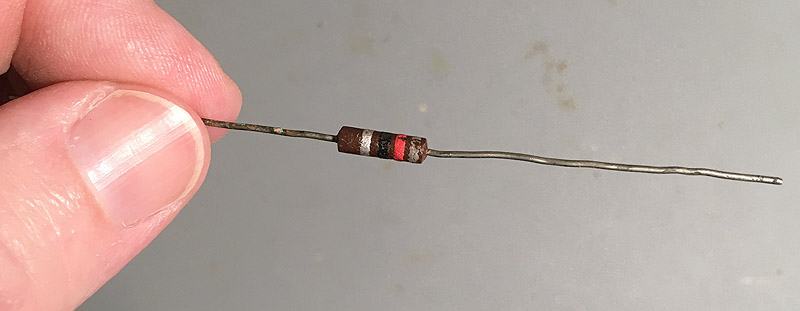
Today, while looking for something else, I came across a memento of the first electronic
circuit design I ever did; that is, the first electronic component that I chose by doing
a calculation.
For Christmas 1964 my parents gave me a Knight-Kit 100-in-1 electronics lab, basically a
breadboard with spring connectors, with a power supply and a control panel.
I had just turned seven years old. A year later, in the fall
of 1965,
I was still avidly experimenting with it, and I had an idea.
One of the simplest projects was simply to supply power to a #47 miniature bulb on the control
panel.
But my idea was that I wanted the bulb to burn dimly, not at full brightness.
So I did a calculation and asked my father for an 88-ohm resistor.
He went to Specialty Distributing Company in Valdosta, where, at the time, you could buy
single resistors for 13 cents each, and came back with the nearest thing they had,
an 82-ohm resistor. (Not 91; the 5% series was not widely used then.)
I put it in series with the bulb, and it glowed a satisfying orange
instead of bright yellow-white.
Success! My father must have bragged about that for a week. Electronic design was pure
wizardry, and there I was, eight years old, doing a bit of it.
The calculation that I had done involved Ohm's Law, carried out with pencil and paper
and possibly a slide rule (which I already knew how to use for simple things).
I am not sure which of two things I actually did.
One possibility is that I looked at the ratings of the bulb (6.3 volts, 0.15 amp)
and wanted to cut its current in half.
Using Ohm's Law, 6.3 volts into (0.15/2) amp gives 84 ohms, which I could have
mis-transcribed as 88.
That would of course not actually cut the current in half because I had forgotten
to include the resistance of the bulb; it would actually run on one third of normal
current, which was satisfactory.
Dim memory suggests, however, that I was mistaken about both the voltage and the current,
and my success may have been a lucky coincidence. I have some recollection of "1/4 amp"
being involved, which of course is not right for a #47 lamp. So I don't know.
In any case, it looked like good engineering.
Incredibly, the resistor survives. When reorganizing my electronic parts in the 1970s, I found
that 82-ohm resistor and put it in a Mason jar that holds some keepsakes of very early work.
I got it out and took a picture of it today.
I also tested it, since carbon-composition resistors do not hold their values well
over the decades. Today it measures 116 ohms.
Permanent link to this entry


|
2020
December
27
|
Tektronix 575 transistor curve tracer

The lull in work has enabled me to get back into my workshop for a few hours.
Let me introduce one of the most imposing test instruments there, a
Tektronix 575 transistor curve tracer ("Tek 575" for short).
(Grammarians take note: The punctuation is "transistor-curve tracer" on the front panel,
and I think that's strictly correct, but everywhere else, this is called a "transistor curve
tracer.")
I first saw one when visiting the UGA Physics Department in 1968, and in 1995 I bought one
at the Atlanta Hamfest. It had recently been surplused by Georgia Tech. I brought it home,
found it in perfect working order, and put it to use.
What it does is make a graph of the flow of current in response to voltage, through
any electronic component, but especially through transistors, where the current flow is
regulated by another current or voltage applied to a third electrode.
By allowing one current to regulate another larger one, transistors are the key parts
of all modern electronics. Your computer contains millions if not billions of them
on silicon chips.
When this instrument first came out, around 1957, transistors were new, nobody could foresee
what new kinds might be invented, and there was huge unit-to-unit variation in manufacturing.
Engineers found it very handy to be able to measure the exact characteristics of
a transistor they actually had on hand, with the voltage and current at which they planned to
use it. Devices not invented at the time, such as SCRs and MOSFETs, are equally easy to test,
and the results are quantitative (not just "it works" or "it doesn't work").
Paradoxically, the Tek 575 doesn't contain transistors, except for just a few.
It's built with vacuum tubes. When it was designed, transistors weren't up to the task of
testing future as-yet-uninvented transistors — which makes sense, if you think about it.
I used my 575 productively just last year.
But it's old enough to have moved from "usable older instrument" to "working antique,
needing careful maintenance."
Accordingly, I am making arrangements for it to retire to a new home in Florida.
In the meantime, here's a look at the inside.
It's classic Tektronix construction, with components silver-soldered into ceramic
terminal strips, and a little roll of silver-bearing solder provided for making
repairs.
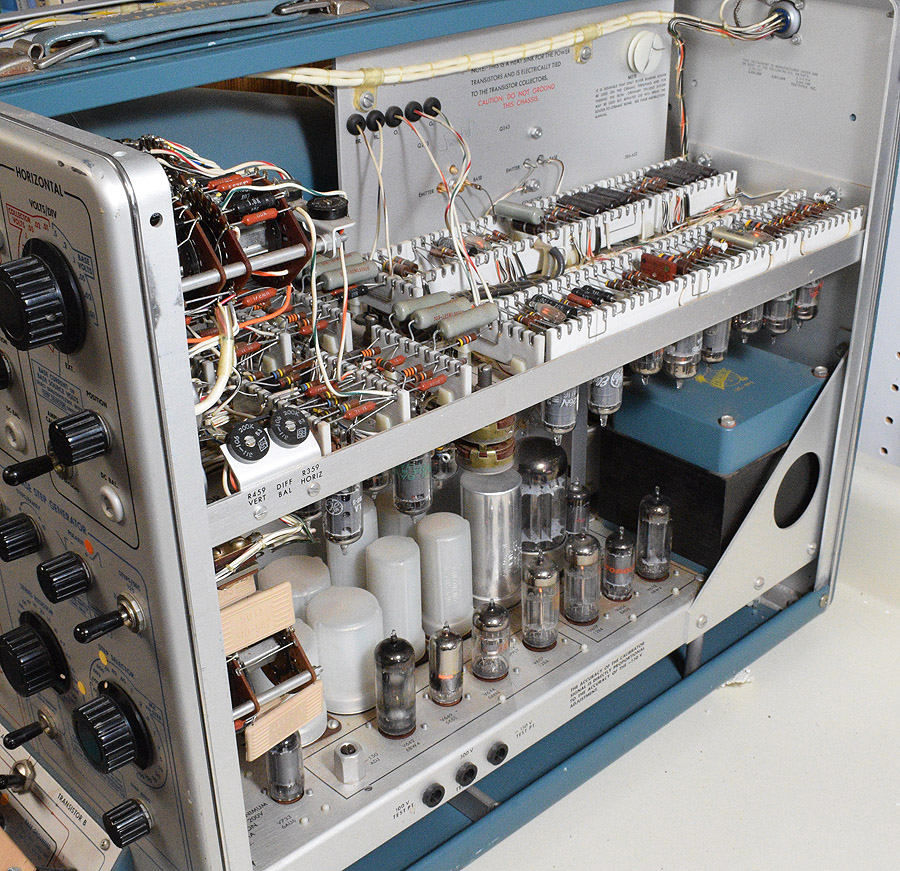
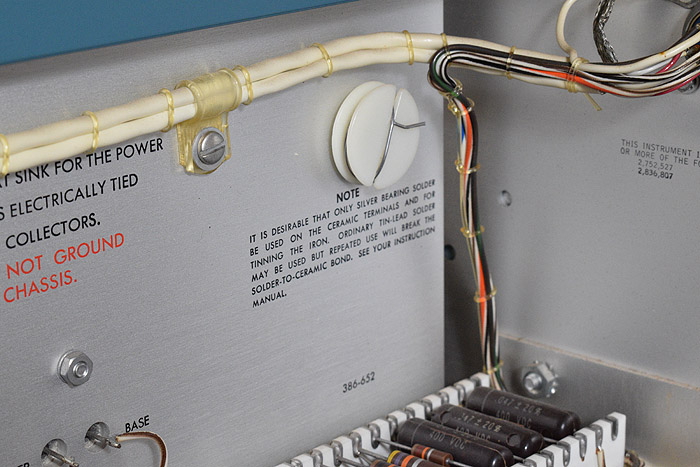
Like all classic Tektronix instruments, the 575 is a masterpiece of analog
circuit design.
Here's some history
and
the technical manual.
See also the
tour of a classic Tektronix oscilloscope
that was in my office at UGA.
Permanent link to this entry
A Brita faucet water filter that doesn't want to go on
A smaller technical triumph was installing a Brita faucet water filter
onto a faucet that it didn't seem to fit. Two adapters were needed.
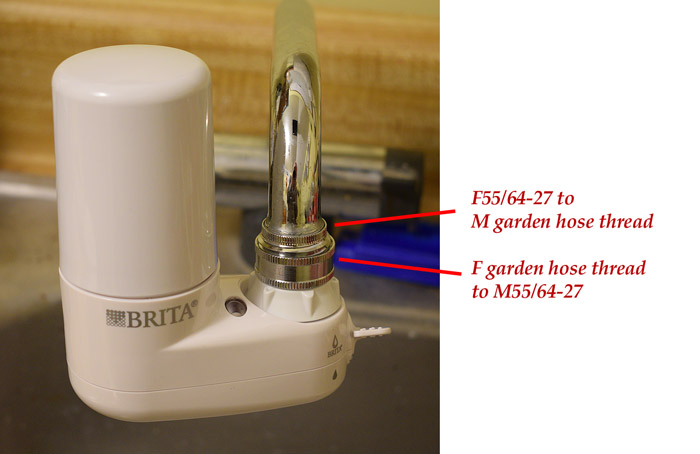
Faucet aerators are usually threaded 55/64 inches in diameter, 27 threads to the inch,
external (M) or internal (F).
I assume this standard was made up by somebody who liked random numbers.
The Brita is threaded F55/64-27 and expects a faucet that is threaded M55/64-27.
So far so good. Brita also provides adapters for faucets that are threaded several
other ways.
Well... my faucet's aerator thread seemed to be the right size, but the Brita would
only tighten onto it about three quarters of a turn, not enough to seal.
Classic symptom of mismatched thread pitch, right? I was sure the European-made
faucet must have a 1-mm thread pitch, or maybe 24 to the inch, or something.
Not so! Out came the calipers and the thread gauges. The threads on the faucet and
the Brita were the same except that the faucet was a few thousandths of an inch
larger in diameter. Both were very close to 55/64 inch, but not identical.
I'm guessing that someone's tolerances went in one direction and someone else's tolerances
went the other way. I know that thread sizes are notoriously hard to match because of
uncertainty about how sharp the ridges should be and where everything else sits relative
to the top of the ridge.
What I needed was an adapter from 55/64-27 to itself, overcoming the thread tolerance problem.
What I got was a pair: 55/64-27 to garden hose thread and then garden hose thread to 55/64-27
(the latter billed as a portable washing machine adapter or something like that).
Both were in stock at Lowe's.
Permanent link to this entry


|
2020
December
25
(Extra)
|
Christmas came
We had Christmas, even in a time of pestilence and political drama.
It was low-key; we used our little ceramic tree, had only a few presents,
and mostly spent our time resting and collecting our wits.
Melody made her best lasagna yet.
The one good thing about Thanksgiving and Christmas in the plague year
is that they are not strenuous. We got some rest.


Permanent link to this entry


|
2020
December
25
|



|
2020
December
24
|
Christmas greetings!
We wish a blessed and safe Christmas to one and all.
We're having a low-key Christmas but enjoying the opportunity to slow down and take a break.
I often get questions about astronomy and the Star of Bethlehem, especially after this
planetary conjunction, which the press touted as "the Christmas Star."
To see what I've had to say, read these entries, in order:
Astronomy and the Star of Bethlehem (2004)
Has the Star of Bethlehem been explained away? (2007)
How could the Star of Bethlehem lead the Magi to Jesus? (2007)
Astronomy and the Star of Bethlehem (2016)
This year I have nothing to add; the "star" may have been a conjunction between Jupiter and Saturn;
or it may not.
Permanent link to this entry
Notes in wartime
The political circus continues, and the third wave of COVID-19 continues to expand, and
life goes on. I keep busy, working for FormFree, which, thank goodness, is mostly (not totally)
shut down for the holiday week.
I ventured to the UGA Science Library yesterday and spent a few minutes looking at
new books and magazines. There were, as far as I could tell, two staff members in the place,
and no one else but me. Of course, the University is on break. But it's still standing.
I remain convinced that this pandemic is like World War II — we will win, but life after
victory will not be a simple resumption of prewar life. Big cities, big crowds, restaurants, and
bars will be much less a part of American life than before. Now that businesses have figured out
how to decentralize, they'll stay that way; nobody will want to pay Manhattan or Silicon Valley rents.
Permanent link to this entry
How to fix Quicken when all else fails
SunTrust accounts connect but will not download new transactions
At the beginning of December, all my SunTrust accounts stopped downloading new transactions into Quicken,
although they showed that they were connecting properly. After a few days, all the personal accounts
resumed working correctly, but the business accounts did not. They were getting a CC-800 error
(accounts deleted), which I was able to clear by repeatedly revalidating the file and reactivating the
accounts, but new transactions still wouldn't download.
Quicken Support gave me the following method for getting Quicken back into its right mind when all
else fails:
- File, Export to QXF
- File, Make a new Quicken file and do not add any accounts to it
- Into the new Quicken file, import the QXF
- Most if not all of the online connections for accounts will need to be deactivated and reactivated ("Link to existing account")
If an account won't reconcile, download it again, and then go through it looking for problems. One of mine had a bogus opening balance.
What this does is preserve the Quicken data you're aware of (accounts and transactions) while discarding the operational
data, such as date of last download.
It can clear Quicken's mind when nothing else will dispel the confusion.
Permanent link to this entry


|
2020
December
21
|
Closest approach

This is the last (probably) in my series of pictures of Jupiter and Saturn taken through
a 200-mm lens, all delivered to you with the same field of view and magnification.
For earlier ones, scroll down through this whole page.
Tonight was the closest approach, just 6.3 arc-minutes, about a fifth of the apparent
diameter of the moon.
Melody, Sharon, and I went on an expedition to our front yard, as we had done on the 17th.
I was delighted to be able to show them the two planets in the field of a 30-power telescope.
But the phenomenon isn't over. Now the two planets will gradually pull apart as slowly
as they came together. They are also continuing to get closer to the horizon, as we swing
around the Solar System, so we're not going to see an exact reversal of what has happened
so far. They will pull apart while continuing to move westward toward the setting sun.
Jupiter and Saturn will still be an exceptional sight for two or three weeks, so
keep watching.
But I didn't manage to get a detailed picture of the two planets close together, for
two reasons: I didn't bring a large telescope down into the front yard, and if I had,
unsteady air would still have interfered. Earlier in the afternoon, around 3 p.m.,
I tried to observe Jupiter and Saturn with a 5-inch telescope while they were high
in the daytime sky, but I could only see Jupiter. That is not surprising, because Saturn
is much dimmer than Jupiter, and the sky was a bit hazy.
But by taking a picture in infrared light (with a dark infrared-pass filter), I did get
something:
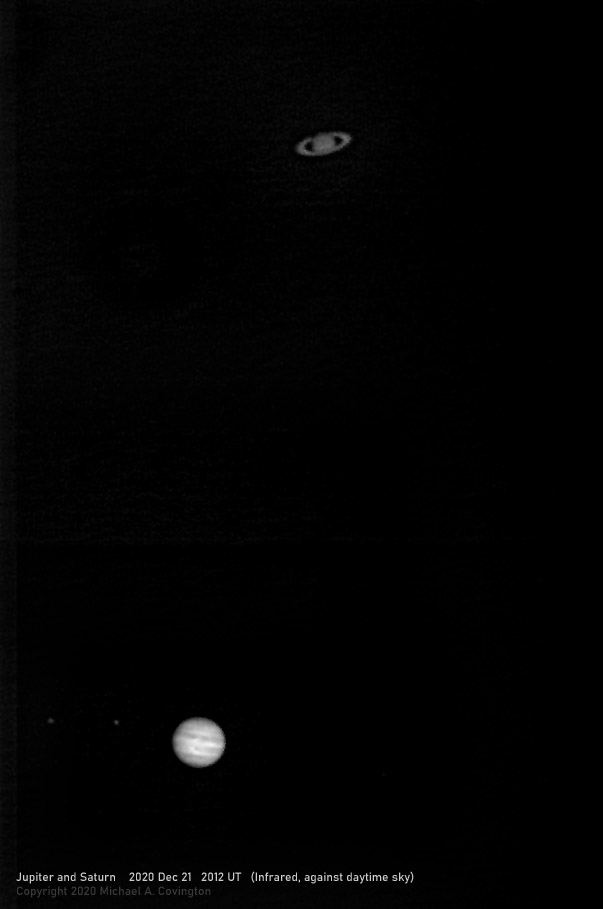
Stack of best 50% of about 5224 video frames, Celestron 5, IR-pass filter, ASI120MM-S camera.
Processing this picture was difficult, and different parts of it are adjusted differently
— a practice I normally eschew, but Saturn was much dimmer than Jupiter, and I was working
so close to the limits of the camera that instrumental artifacts were a problem.
Permanent link to this entry


|
2020
December
19
(Extra)
|
And even closer!

Jupiter and Saturn are now only 13 arc-minutes apart, less than have the apparent
width of the moon. Like the other pictures below, this is the full field of a 200-mm
lens, and the magnification is the same. I switched from an H-alpha-modified Nikon D5500
to an unmodified D5300, which has the same sensor but gives much better color rendition.
This time I was dodging clouds.
Here's a magnified, cropped portion of a similar picture from the same session with a
slightly shorter exposure. You can see Saturn, four satellites of Jupiter, and Jupiter itself.
The bright planets are overexposed, and as a result, you can't see the gap between the rings
and ball of Saturn, but you can see that the whole thing is elliptical.

Permanent link to this entry


|
2020
December
19
|
Closer yet!
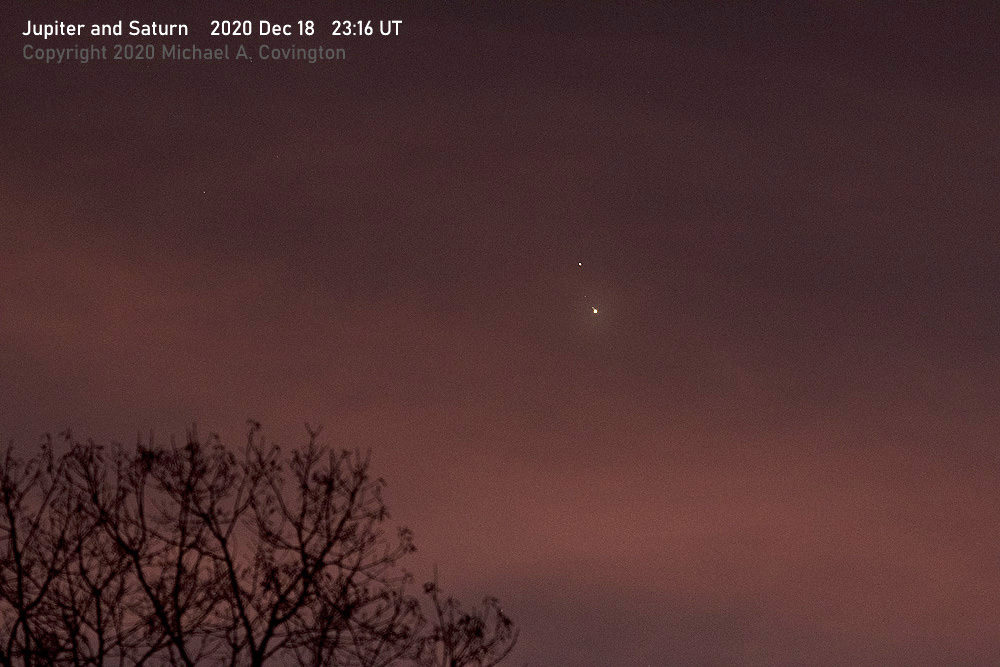
Closer yet, but with high clouds. This is from last night (Dec. 18).
We have some cloudy weather coming in, and then I hope to photograph the planets
when they are closest, on Monday.
All the pictures in this series are taken with the same lens and have the same field of view
and magnification.
Permanent link to this entry


|
2020
December
17
|
And closer...

Jupiter and Saturn are now less than one moon-width apart.
For tonight's pictures I had to make an expedition to the front yard.
I call it an expedition because the narrow strip of grass that has a good
southwest horizon is so inaccessible from the house that I used the car
to get the equipment down there and back.
Parking the car on the street also helped keep other cars away from me.
Above you see the full field of the same 200-mm lens that I've used for the other
recent pictures (scroll down); all are to the same scale.
Some of the moons of Jupiter are visible.
This exposure was 1 second
at f/4 with a Nikon D5500(a) at ISO 400. Although you can't see it in this reduced
image, there was slight trailing, and I should have gone up to ISO 1600 and used 1/4 second.
Melody joined me on the expedition and we shared the rare experience of seeing two planets
in the field of the telescope at the same time. We used a 65-mm f/6.5 apo refractor at 15 power;
not a powerful telescope! But it did the job.
I also prepared to take a telescopic picture of the two planets together on Monday.
They're not close enough for that yet, but I photographed Saturn to see what level of
quality to expect. This is from a video taken on a Canon 60Da in "movie crop" mode,
using only a very small part of the sensor, and stacked and sharpened. The air was
unsteady, and I took only 12 seconds of video, so I expect distinctly much better results Monday.
Then, Jupiter will also be in the picture, somewhat overexposed.
Here's what I got on this trial run:

Permanent link to this entry


|
2020
December
14
|
Closer now!
Jupiter and Saturn are looking closer together in the sky now — they will
seem almost to collide on December 21. (Actually, Saturn is much farther away
than Jupiter.) This picture was taken on the evening of the 13th.
Click here to see how they looked on the 5th
with the same camera, lens, and magnification. This time, high clouds added
a slight blur.
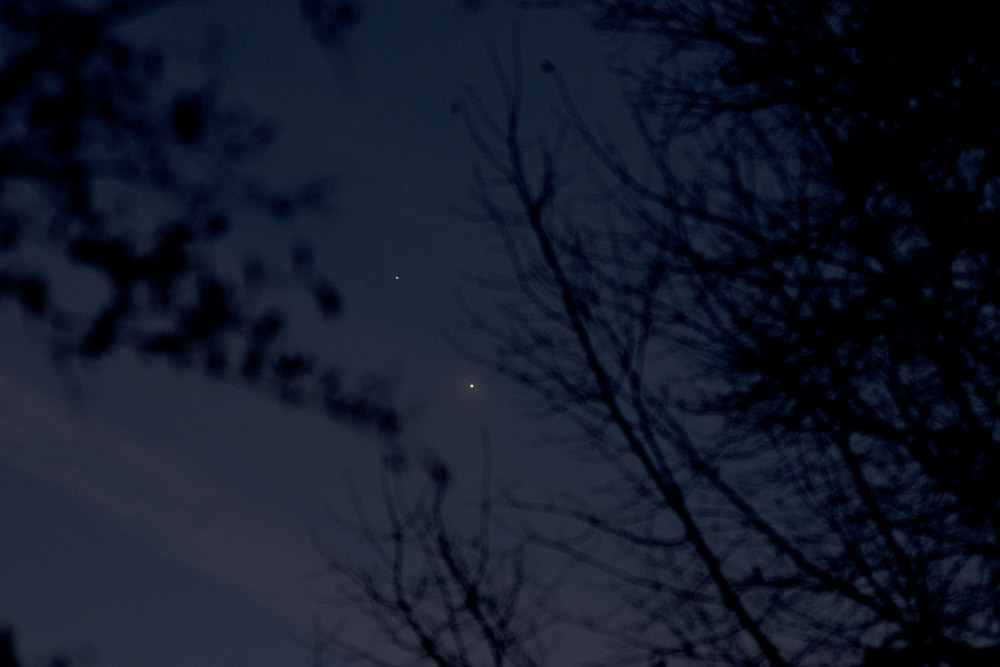
Nikon D5500 (H-alpha-modified) on fixed tripod, Askar 200-mm f/4 lens at f/4, 1/8
second, ISO 400.
Permanent link to this entry


|
2020
December
13
|
Practical reasoning is not like mathematical proof
Here is a point of logic that I have never heard anybody talk about, except professional logicians...
Reasoning about human affairs and knowledge (politics, law, even science) is not like the reasoning in a mathematical proof.
Mathematical proofs are self-contained. If a proof is correct, then it definitely proves its claim, and nothing can change that. All the information that can affect it is included.
Reasoning in the real world is always subject to revision from new information. Logicians call this nonmonotonicity. All the information you start with is fallible, and even if none of it is incorrect, you can always get more information that complicates the situation and changes your conclusion.
On matters of law and politics (and even in the Supreme Court amicus briefs) I am seeing lots of plausible arguments that are presented like mathematical proofs: Believe all these premises, and the conclusion follows, so the conclusion has to be true. No... it only has to be true if the premises are all true and nothing else is relevant.
If you start with a half-truth, then even the best logic will still give you only a half-truth.
That is why, when forming an opinion about anything, I seek information from all sources. I'm wary of anybody who tells me to ignore sources of information. I want to know what all sides are saying, even if they're wrong. Under no circumstance will I obey an order to keep myself ignorant.
For more about how classical mathematical logic is not sufficient for all reasoning,
click here.
This not some wild new idea;
the points made in that presentation are uncontroversial.
Permanent link to this entry


|
2020
December
10
|
Supreme Court circus
The
Supreme Court
docket page
for the Texas election lawsuit has become an online forum as people
all over the country
see documents and file amicus briefs to respond to them, almost in real time.
I suppose one way the suit could be drawn out would be by a never-ending cascade
of amicus briefs — I hope that doesn't happen, and the suit reaches a quick end.
Texas is suing to throw out the electoral votes of four states that allegedly changed their
election procedures in ways not permitted by their own laws,
in some cases not uniformly throughout the state, and in such a way as to raise the
risk of bias or fraud.
I recommend reading
Texas' original complaint
and
Georgia's response, the best-written of the responses
I've seen so far.
I am archiving copies of them on my own web site.
I want all my fellow citizens to understand that
the outcome will depend on facts about events, the law, and prior court cases,
not how strongly people feel about something or how loudly they speak out.
It is not clear that all the documents in the case show understanding of this.
If I were qualified to file an amicus brief myself, I would, and it would say:
The case is moot because the plaintiff's request for remedies can be satisfied
without changing the winner of the election.
The plaintiff requests: "If any of Defendant States have already
appointed presidential electors ... using the 2020 election results, direct such
States’ legislatures ... to appoint a new set of
presidential electors ...
or to appoint no presidential electors at all."
(Bill of Complaint, p. 40, paragraph E.)
Taking the second alternative, if the four named states appoint no electors,
Biden would still have a "a Majority of the whole Number of Electors appointed"
(U.S. Constitution, Art. 2, Sec. 1), which would then be 244 to 232.
I also want to point out that the most Trump can possibly win is a very embattled presidency.
More than half of Americans voted against him, and many of his former supporters are turning away.
Many Americans, and almost all foreigners, will feel that he is not a legitimate president.
Follow-up: The Supreme Court dismissed the case and said only the following:

But before they did that, they received
a brief
from two imaginary, nonexistent states
(too funny to forget, so I'm archiving it here).
And yesterday Rush Limbaugh was on the radio talking about breaking up the United States.
And the Arizona Republican Party, on Twitter, reportedly asked if people were "willing to die" for the
cause — the cause of keeping Trump in office. (By what means, pray tell?)
The striking thing about this circus is the way it has separated from the mainstream of
American politics, including conservative politics.
It is off in fantasyland.
Plenty of people supported Trump's policy platform (he was, after all, the
only conservative on the ballot) but have lost patience with this.
And the circus is shrinking. The voices get louder and crazier, but the crowd
gets smaller. I think we have been watching some people sacrificing their political
and even legal careers. The circus won't continue forever, and then where will they be?
[Further follow-up:]
The right-wing voices that I'm hearing are all skipping right past the question of fact
whether Georgia and the other three states actually violated their election laws.
The states argue cogently that they didn't.
It is not enough to just say they did.
Accusations do not become true just because someone utters them.
Permanent link to this entry


|
2020
December
5
|
Start watching Jupiter and Saturn now

This is how Jupiter and Saturn looked this evening, through a 200-mm lens.
This is roughly how they looked in binoculars. You can see some of the satellites
of Jupiter (like tiny stars in a row next to it), and Saturn is, perhaps,
perceptibly football-shaped (it's too overexposed to show the rings properly).
They were about 1.7 degrees apart, the width of a thumb at arm's length.
Between now and December 21, they will get much closer.
Permanent link to this entry
Honest minds as well as honest tongues:
a sermon on the Ninth Commandment
The thing that has sickened me the most over the past several years,
and has really come to a head during the present political turmoil, is how
so many of my fellow Christians delight in spreading accusations of wrongdoing
without adequate evidence. Politics is no longer about what each politician
can do for us; it's about what evil some other politician has done. And Christians
no longer have any qualms about oversimplifying and exaggerating the facts,
or even passing off fantasies as facts, in order
to help "the right side" win.
So today, for my Christian audience on Facebook, I posted the following.
I trust that all of you will agree with the point of morality, regardless of
your religion.
Fellow Christians, THIS IS IMPORTANT.
Those who need to read this probably won't read it. But it needs to be said.
"Thou shalt not bear false witness against thy neighbour" is still in the Bible.
This is not just about what you say with your mouth or keyboard, it's also about what you tell yourself in your own mind.
It is a sin, yes a sin, to allow yourself to believe an accusation without good evidence, or give it more credence than the evidence warrants. You are bearing false witness with yourself as the audience.
I know that in the political world, many people's wrongdoing is a matter of public concern, and even when the evidence is quite unclear, it needs to be discussed and pursued.
But if you claim to know God, you are obligated always to be as accurate and fair-minded as you possibly can.
Let me hammer that home. As accurate and fair-minded as you possibly can.
That comes with being a Christian —
comes with the Ten Commandments and the Book of Proverbs — not to mention the Gospel itself.
If you're looking for a place where you can pretend not to know right from wrong, the Kingdom of God is not it.
This means you are not allow to jump on conspiracy theory bandwagons (which are usually massive violations of the Ninth Commandment) and fill your mind with trash from propaganda web sites.
You are not allowed to pass along accusations just because you heard them somewhere.
You are not even allowed to believe
accusations of wrongdoing just because you feel like believing them,
because they are juicy stories or give a thrill of alarm or anger.
Imagine if Jesus Himself asked you why you are saying what you're saying, and whether you've checked the facts and thought through the evidence yourself. "No, I'm just passing along something I heard." Boom. Ninth Commandment violated.
Permanent link to this entry


|
2020
December
3
|
What Jupiter and Saturn will do on December 21

On the evening of December 21, Jupiter and Saturn will appear so close together in the sky that they will look almost like a single bright star. The closest pass is around 6:30 p.m. Eastern time on the 21st, but they are exceptionally close for a couple of days.
They will not be close together in space; Saturn is much farther away than Jupiter. They pass by each other every 20 years, but because their orbits aren't perfectly parallel, they usually don't pass this close.
Where is this visible? The whole world gets a good view, but the eastern United States is particularly well positioned. Western South America is even better.
Jupiter and Saturn will be low in the southwest after sunset. You'll have to get away from trees, into an open field, because they will be quite close to the horizon.
You can start now. Start watching Jupiter and Saturn every evening. They are low in the southwestern sky after sunset every night, slowly getting closer together. They look like stars. Jupiter is the brightest "star" low in the southwest sky. The moon passes near them on December 16, 17, and 18, and will be past them (farther east) by the 20th.
No telescope needed: The best view will be with the unaided eye or binoculars. If you have a telescope, you'll be able to see both planets in the same field.
What does this have to do with the Bible?
Nothing, except that an event similar to it, in 7 B.C., may have been the Star of Bethlehem. (It's not clear whether it really fits the description, and the date may be too far off.) This is not a mysterious or unexpected event; Jupiter and Saturn are just going along in their regular orbits, as they always have done.
I have been dismayed at the way the Internet has become full of religious or superstitious interpretations
of this perfectly natural event.
Permanent link to this entry
Strange adjectives
One of the pleasures of Facebook is being able to talk about my profession (linguistics) with friends
who are world-class experts. And one of my most longstanding scientific interests has been the question
of how the meanings of words combine to form the meaning of a sentence. This is of course vitally
important for making computers understand human languages.
Yesterday and today, several of us had an interesting conversation about adjectives. Here are the
main points.
Consider the phrase black dog. You can account for its meaning in a simple way: Consider all
the things that are black, and all the things that are dogs. The things that are both are black dogs.
But it's not always that simple. Sometimes the noun alters the meaning of the adjective.
Consider for example skillful carpenter. That is not just someone who is skillful and
is a carpenter. He or she has to be skillful at carpentry, not at, say, riding the unicycle.
The meaning of skillful is narrowed by the way it combines with carpenter.
And sometimes the adjective narrows or broadens the meaning of the noun.
Consider counterfeit coin. That means something that is not a coin in the usual
sense of the word, but is still a coin in some broader sense.
Conversely, a real coin is one to which the word coin applies without
that kind of broadening. A true Scotsman is one who is a Scotsman in the
strictest sense of the word.
Some linguists would say that counterfeit is a PRIVATIVE ADJECTIVE,
meaning that it flatly denies what is normally meant by the noun.
But a counterfeit coin isn't merely a thing that is not a coin; it is not,
for instance, the same thing as a counterfeit railway ticket.
That is why Barbara Partee and others argue that
there are no really privative adjectives, only adjectives that force broadening of the
meaning while denying the strict sense.
We didn't get into adjectives that involve a sense of scale, such as big mouse
and small elephant. Here big and small are influenced by mouse
and elephant somehow, so that a big mouse is smaller than a small elephant.
Permanent link to this entry
A strange chapter in American history
American politics has never been stranger, and I want to mention a few things just to
chronicle the weirdness for posterity.
Since the election, our president has not been able to accept that he lost, and his team
has introduced a flurry of lawsuits in various states, none of which have presented any actual
evidence of fraudulent voting. They have been thrown out of court, even by judges that
Trump himself appointed.
Of course, if there is any actual evidence of fraud, we all need to hear it. But it seems
unlikely that the election was "stolen" by the Democrats because (1) they didn't steal the
Senate, which they needed at least as much as the presidency; (2) polls showed Biden winning;
(3) Biden clearly won the popular vote, and Trump never aimed to do more than win in the
Electoral College. Without debating the whole issue of the Electoral College, let me just say
that I don't think the Founders intended for it to be used regularly and intentionally as a
way to subvert the popular vote.
Meanwhile, Trumpism is becoming increasingly detached from conservative politics, to the point
that Trump denounced Georgia's (Republican) Secretary of State as "an enemy of the people"
(Stalin's phrase) because
he reported Biden as the winner in Georgia.
That Secretary of State is now getting death threats, and so are other election officials
and at least one young voting-machine technician, all
because they didn't
make Trump win. A full-page ad in yesterday's Washington Times called for the president
to impose "martial law" and re-run the entire election. And the loony right wing has flocked
to Parler (a competitor to Facebook) and YouTube to spread what are clearly delusions.
We are hearing total lunacy, such as "North Korean ships were delivering fake ballots in Maine."
I was particularly saddened to read about a "militia" in Texas that offered to fight
(physically, with guns) to keep Trump in power.
These men have jobs and families. Do they really want to die in an armed uprising
against the United States? Even if they have twenty more militias to join them, they are
no match for our armed forces. It's pathetic. The "militias" seem to imagine they
are playing a video game.
Meanwhile, most of America is simply ignoring this foolishness.
On January 20, we will have a new president.
I regret, however, that we apparently
have a vacuum at the top right now — the Biden transition team is leading the nation
more than Trump is; Trump is doing nothing but grumble about the election. He will hold a "rally"
in Valdosta (my birthplace) on Saturday to campaign for the Republicans in Georgia's two Senate
runoffs. Meanwhile, other Republicans are telling each other not to vote in the runoff because the
whole process of voting is corrupt. I think they want to lose so they can grumble more.
Permanent link to this entry


|
|
|
This is a private web page,
not hosted or sponsored by the University of Georgia.
Copyright 2020 Michael A. Covington.
Caching by search engines is permitted.
To go to the latest entry every day, bookmark
http://www.covingtoninnovations.com/michael/blog/Default.asp
and if you get the previous month, tell your browser to refresh.
Portrait at top of page by Sharon Covington.
This web site has never collected personal information
and is not affected by GDPR.
Google Ads may use cookies to manage the rotation of ads,
but those cookies are not made available to Covington Innovations.
No personal information is collected or stored by Covington Innovations, and never has been.
This web site is based and served entirely in the United States.
In compliance with U.S. FTC guidelines,
I am glad to point out that unless explicitly
indicated, I do not receive substantial payments, free merchandise, or other remuneration
for reviewing or mentioning products on this web site.
Any remuneration valued at more than about $10 will always be mentioned here,
and in any case my writing about products and dealers is always truthful.
Reviewed
products are usually things I purchased for my own use, or occasionally items
lent to me briefly by manufacturers and described as such.
I am no longer an Amazon Associate, and links to Amazon
no longer pay me a commission for purchases,
even if they still have my code in them.
|
|























